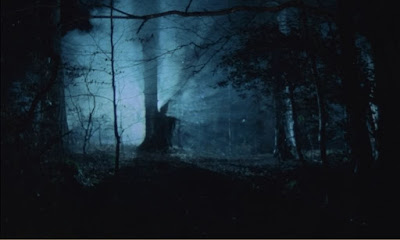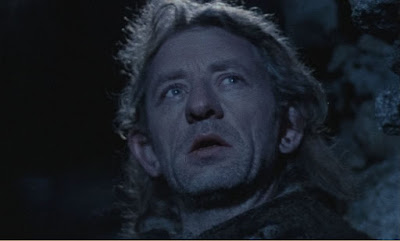A sense of time when magic had a meaning... I wanted
to create a myth that was relevant to human experience.
Robert Wynne-Simmons
This film is set in a time before the potato famine, when
Ireland was a much more populous place and a happier one. Maybe that’s a
projection – a long standing one – but so much of the country becomes so hard
to view at this distance, especially when every one of you was called James
speaking personally, that it’s much clearer to imagine. So it was that a man
from Sussex, educated in Cambridge University, came to write and direct what
was the first independent Irish film made in half a century.
Robert Wynne-Simmons had previously tackled William Blake
and then the screenplay for the ultimate “folk horror” film, Blood on
Satan's Claw directed by Piers Haggard the man who really coined the
phrase. Wynne-Simmons had been working in Ireland and managed to, just about,
secure the funding for this labour of love which both answers the question
about what Irish cinema could be and highlights the riddle of why not more? It
is after two viewings, a film to bewitch and fall in love with, something the
director has been shocked by when he meets people who have been so deeply
affected by the tale.
Cyril Cusack is the big name in the film and he was,
according to his director, very proud to have been in both this film and the
last independent Irish film, Guests of the Nation a silent film from
1934, directed by Denis Johnston, and including Barry Fitzgerald. The Irish
Film Board was set up in 1981 to boost the local industry, and Outcasts
certainly benefited from this backing along with Channel 4.
Cusack is of course wonderful; he was a master of nuanced
uncertainty and always conveyed mystery in his thoughts in ways utilized so
well by Michael Powell and Emeric Pressburger whose style of “magic realism”
runs through this film like the words Galway Bay running through a stick of seaside rock. But there’s a young performer called Mary Ryan who steals the film with
an almost mystical connection to the camera that you wouldn’t credit from
someone who was stage trained and with scant film experience.
Ryan plays Maura, a woman out of step with her fellow
villagers and even her family. She describes herself as a “mistake” and her
father’s regular if “well-intentioned” beatings are testament to her inability
to bend to his will. She is out of joint, seeing things her sisters don’t and
being relentlessly teased by the locals as we see at the film’s beginning when
two other girls throw her petticoat into the mud, forcing her to face the
indignity of wearing them. People are cruel but she has a strength in not
responding, almost as if she sees through their mundane games.
Like much else in the film, the explanation is left open
to the audience to interpret, as the BFI’s Vic Pratt says in his booklet essay,
ambiguity abounds; slippage of meaning is manifest... Maura’s sister Janey
(Bairbre Ní Chaoimh) is due to be married to Conor Farrell (Tom Jordan) who
has, it seems, put her in the family way. Their issue is discussed with local
civic leader Myles Keenan (Cyril Cusack) who arrives imperiously on horseback
with a shiver at the prospect of his old adversary Scarf Michael (Michael Lally),
who appears to him as a reflection in a pool. This apparition and the plaintive
fiddling is surely in his imagination or is it?
The wedding is agreed with old grudges put aside by
stubborn, grounded men, as much a part of the scenery as the buildings and even
the clothes feel rooted in the muddied earth, the dampness working its way up
the hems as the actors struggled against the elements. This is a “folk film”
before it’s a horror and the old behaviours and traditions are as mysterious as
any witchcraft. For the wedding party the youngsters run to the house and then
a band arrive carrying fiddles and dressed as Straw Men, Maura stares at these unknowable
men who ae welcomed in to serenade the party without question. That’s wyrd in
the old sense of the word and as frequently quoted by Dr Diane A Rodgers in her
excellent and informative commentary. Another level of the uncanny is added by
the faraway sounds of Scarf Michael’s fiddle… causing anxiety among the adults.
As the evening progresses the younger members of the
group wander off into the woods, leaving Maura alone as they pair off. She
waits in the eerie darkness with slivers of moonlight hinting at the uncertainty
of what’s beyond. Now she sees the figure of Michael, who appears to be there
and not there until he solidifies and approaches her. She joins him as he
exacts magical revenge on her tormentors as the drink and make love and she
enjoys the tables turned while it lasts.
The next morning, she wakes in a graveyard with Michael –
he often sleeps in such places “for the company” – only to find herself covered
in snow. It’s as if the world has changed but the reality was more prosaic as
the unexpected snow had slowed production even as it allowed for this deft
stroke from the director. Soon though the locals are turning on Maura and blaming
her for blighted potatoes and consorting with the unnatural Michael. Will he
save her, and, even as he holds back from revealing the truth of what he knows
and she longs to find out, we wonder what will become of her…
Wynne-Simmons’ team clearly laboured with a love of the
subject and in his essay in the booklet he is quick to credit them feeling
privileged by the way in which both cast and crew responded to the creation of
this ‘other world’.
 |
| People and the earth |
Séamus Corcoran, the lighting cameraman, had a deep
understanding of the countryside and of the light in people’s eyes. Consolata
Boyle created costumes that seemed to grow out of the ground itself. Stephen
Cooney’s beautiful music was enhanced by dark didgeridoos from his native
Australia, emphasising how the human subconscious unites all the world.
As the Englishman telling this most resonant of Irish folk tales there’s a touch of Bruce Chatwin’s belief in the universality of folkloric “songlines” which echo down from the past through our generations be they describing Cooney’s outback, the Pilgrim’s Way to Canterbury or the invisible ties that bind in Isle of Kiloran. Maura experiences her landscape as a revelation and one that she will have to discover how to share with her family and others outside of her higher consciousness.
Extras are magical:
·
New 2K restoration by the Irish Film Institute
·
Newly commissioned audio commentary by Dr Diane
A Rodgers
·
Writing Folk Tales (2024, 9 mins): a newly
recorded interview with director Robert Wynne-Simmons
·
The Fugitive (1962, 31 mins): Robert
Wynne-Simmons’ first film with an outsider at its heart is this dark tale of
violence, guilt and retribution shot on 8mm film amidst Mods and Rockers
violence on the backstreets of ‘60s Brighton
·
The Outcasts in Pictures (2024, 15 mins):
a gallery of stills from the film with audio commentary by director Robert
Wynne-Simmons
·
The Wanderings of Ulick Joyce (1968, 5
mins): this distinctive animated short by Gillian Lacey was inspired by Irish
folk tales, and was made with the assistance of the BFI Production Board
With the first pressing only, there’s a very
impressive booklet including director’s statement, new writing on the film by
the BFI’s Vic Pratt, an archive essay by Dr Diane A Rodgers and recollections
of The Fugitive by Robert Wynne-Simmons.
It’s out now, so get your order in quickly – this is a
film you’ll want to watch over and again, a puzzle open to interpretation and
one that will touch each of us in different ways. A wonder.






















No comments:
Post a Comment